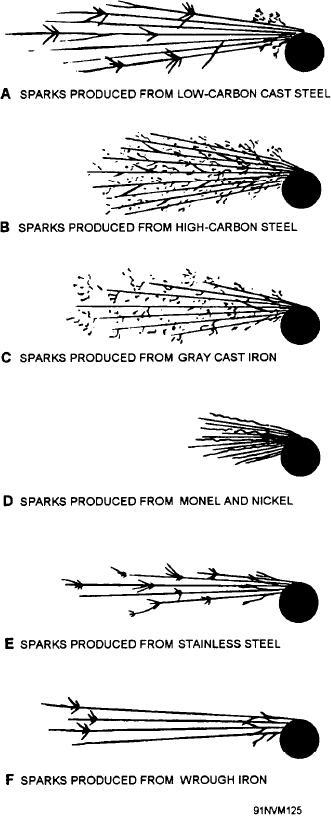that after a little while, you will form a mental image of
the individual spark. After you can fix the spark image
in mind, you are ready to examine the whole spark
picture.
Notice that the spark stream is long (about 70 inches
normally) in low-carbon steel, and that the volume is
moderately large; while in high-carbon steel, the stream
is shorter (about 55 inches) and larger in volume. The
few sparklers that may occur at any place in low-carbon
steel are forked, while in high-carbon steel the sparklers
are small and repeating, and some of the shafts may be
forked. Both will produce a white spark stream.
White cast iron produces a spark stream approxi-
mately 20 inches in length (see fig. 6-11). The volume
of sparks is small with many small and repeating spar-
klers. The color of the spark stream close to the wheel
is red, while the outer end of the stream is straw colored.
Gray cast iron produces a stream of sparks about 25
inches in length. It is small in volume with fewer
sparklers than white cast iron. The sparklers are small
and repeating. Part of the stream near the grinding wheel
is red, and the outer end of the stream is straw colored.
The malleable iron spark test will produce a spark
stream about 30 inches in length. It is of a moderate
volume with many small, repeating sparklers toward the
end of the stream. The entire stream is straw colored.
The wrought iron spark test produces a spark stream
about 65 inches in length. The stream is of large volume
with few sparklers. The sparklers show up toward the
end of the stream and are forked. The stream next to the
grinding wheel is straw colored, while the outer end of
the stream is a bright red.
Stainless steel produces a spark stream approxi-
mately 50 inches in length, of moderate volume, with
few sparklers. The sparklers are forked. The stream next
to the wheel is straw colored. The sparks form wavy
streaks with no sparklers.
Monel metal forms a spark stream almost identical
to that of nickel and must be identified by other means.
Copper, brass, bronze, and lead form no sparks on the
Figure 6-11.--spark pictures formed by common metals.
grinding wheel, but they are easily identified by other
means, such as color, appearance, and chip tests.
You will find the spark tests easy and convenient to
have similar spark patterns. It is the practice in many
make. They require no special equipment and are adapt-
metal shops to maintain a cabinet of commonly used
able to most any situation. Here again, experience is the
metals, positively identified as to grade, for com-
best teacher.
parison with unknown samples.
It is good practice to compare the sparks of an
Proper lighting conditions are essential for good
unknown metal with those of a known metal. This
spark testing practice. Testing should not be done in
permits an additional check on the tester's conclusion
and also can distinguish between different metals that
6-16






